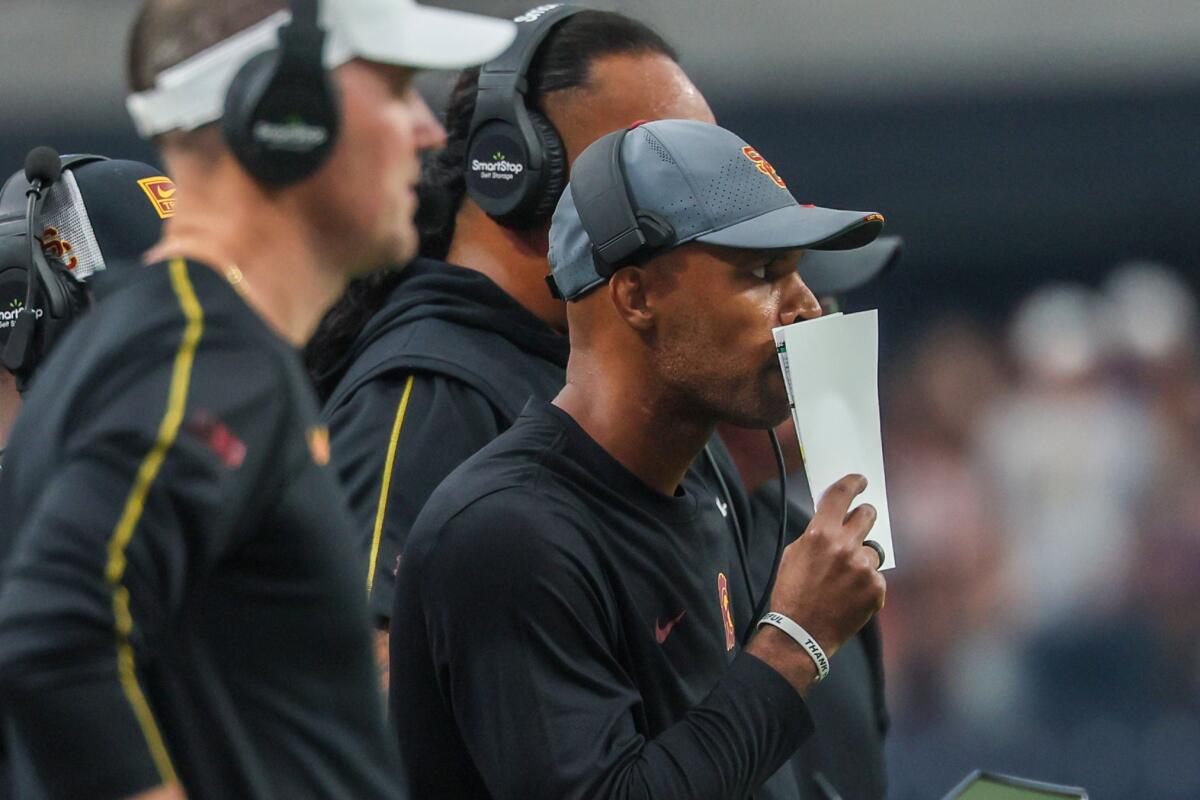The Times of Troy: Welcome to our new USC sports newsletter

Hello, everyone! I’m Ryan Kartje, your friendly neighborhood USC sports beat writer at the L.A. Times. I feel as fresh as the parent of a congested 1-year old can coming off a bye week, and I’m ready to roll out our latest newsletter — The Times of Troy. It is tailored entirely for Trojans fans.
This is my sixth season on the USC beat, and boy have we covered a lot of ground together in that time. We’ll cover even more in this space in the months to come, sharing with you the stories behind the USC stories you read in our newspaper and online. As the Trojans and our Times readers enter new, unfamiliar territory in a new, unfamiliar conference, I’m thrilled to tap into my Midwestern roots to serve as your guide during USC’s inaugural season in the Big Ten.
Fight on! Are you a true Trojans fan?
Get our Times of Troy newsletter for USC insights, news and much more.
You may occasionally receive promotional content from the Los Angeles Times.
With that in mind, there’s no more natural place to start our journey together than Ann Arbor, Mich., home of the defending national champions and the world’s greatest deli — more on that later — and just a short drive up US-23 from my hometown of Milan, Mich., where my dad raised me on Bo Schembechler and three yards and a cloud of dust.
I graduated from Michigan after the worst four years in the football program’s history, and I haven’t been back to the Big House in a decade. But I have seen enough mediocre Michigan football in my life to know when the Wolverines are vulnerable. And let me tell you, Tom Brady ain’t walking through that door in 2024.
USC has a legitimate shot Saturday to beat Michigan in the Big House and catapult itself into the College Football Playoff conversation. But doing so will probably come down to adjustments made by both defenses and the chess match between the two men leading them, D’Anton Lynn and Michigan’s Wink Martindale, both of whom know each other’s philosophies as well as their own.
Let’s get defensive
The origins of the scheme that Lynn has used to turn around the Trojans defense can be traced back, in some form, to the University of Cincinnati in 1996.
That’s when Rex Ryan, then the defensive coordinator at Cincinnati, first crossed paths with Martindale, the Bearcats’ defensive line coach. The two men would become fast friends and close influences, each with deep affection for blitzing the quarterback.
Lynn was still in elementary school at the time. But two decades later, as head coach of the Buffalo Bills, Ryan hired Lynn, then 26, and mentored his defensive assistant. During two seasons together, he taught Lynn many of the principles he honed with Martindale at Cincinnati, including the importance of deception and the use of simulated pressure to disguise pass rushers.
Ryan never got a coaching job again after leading the Bills in 2016. But Martindale, who went on to become the Ravens’ defensive coordinator, hired Lynn as his safeties coach in 2021. They spent just one season together, but Lynn said Martindale made an impact on how he thinks about play-calling.
“Him and Rex were two of the most creative guys in the NFL,” Lynn said.
The NFL agrees. Their scheme, predicated on deceptive pressure and popularized by that Ravens staff, has become one of the most influential in football. Some form of that system is being run by the Dolphins, Titans, Chargers, Seahawks and Ravens. Martindale and Lynn have since brought it to the college game.
Although the system is everywhere, the varying forms of it are difficult to distinguish.
“The system itself is so flexible,” Lynn said, “that five different people can have the same playbook, and it looks completely different. In my opinion, when I watch us play and I watch Michigan play, it doesn’t look like the same defense.”
Which is kind of the point.
“We all have our different personalities,” Martindale told reporters earlier this year. “Some are more aggressive. Some are less aggressive. But the thing I love about it is the system works. It’s proven.”
The system is predicated on keeping opposing offenses guessing. Although the defense might look the same on any given play, the central tenet of the scheme relies on the offense having no idea where pressure could be coming from, if at all, making it impossible to get a bead on what the defense is doing at any given moment. Sometimes it could look like eight are about to rush, only for five defenders to drop back in coverage right at the snap.
In many ways, it’s the same principle Sean McVay uses to power his Rams offense, which relies on disguising different concepts to look exactly the same.
“I want them to think, ‘They could be bringing five, they could be bringing six.’ We could also be bringing four. We could also be bringing three,” Lynn said. “We want it to look the exact same, but we don’t want them to know when or where it’s coming.”
What happens when both coordinators know the other well enough to anticipate that next move? Or counter that move with a different move? That’s why Saturday’s game is expected to be a particularly intriguing chess match.
Through two games, Lynn looks several moves ahead of everyone else. If that trajectory continues this season, he may not be around USC for long.
Asked this week if he had head coaching aspirations, Lynn said, “Down the road.
“Right now, I have a lot in front of me and I have a lot for me just to grow as a coach.”
Some USC fans flew into a panic when they saw that response. But when you hire successful coordinators — something USC hasn’t done in quite a while — then they do tend to get opportunities elsewhere. This is just how it works.
Whether that would happen after one season remains to be seen. It’s only been two games, after all. And Lynn just left one school after a single year — would he really leave another? My instinct would be that an NFL defensive coordinator job would suit him better than a college head coach.
But wherever he ends up, Ryan, his mentor, knows his climb is just beginning.
“This kid,” he said, “is a superstar.”
Enjoying this newsletter? Consider subscribing to the Los Angeles Times
Your support helps us deliver the news that matters most. Become a subscriber.
Extra points
With in-helmet communication now allowed, it seemed like a certainty that inside linebacker Easton Mascarenas-Arnold would don the green dot on USC’s defense. But USC switched gears in camp, instead giving the responsibility to his brother, safety Akili Arnold.
Lynn shrugged off the change, pointing to the fact plenty of NFL teams use free safeties to relay signals. For Arnold, it just means yelling loud enough to ensure the defensive line can hear him.
“It’s cool. It’s kind of like a video game,” Arnold said, “and I’m the man in command.”
Speaking of new technology, it doesn’t seem as if Lincoln Riley is much of a fan.
“You still gotta be able to translate it,” Riley said. “You gotta be careful. We’re all so used to just sitting there and just poring through film. You got to be careful about that because the game moves fast and there’s a lot going on, and you’ve gotta try to obviously figure out, ‘What can I take from this in this moment?’ and then move on and try to find a positive impact in the game with it. So we’re probably all navigating through that still right now. But getting used to it. I mean, the purist in me doesn’t love it, but I mean, you’re getting used to it, and there’s certainly some advantages with it.”
- USC quarterback Miller Moss has one of the quickest triggers in college football through two games. Against Utah State, his average time to throw was just 2.02 seconds. That’s even faster than his Week 1 average of 2.35 seconds. Only three quarterbacks in college football have been quicker through two weeks, and so far, the quick trigger from Moss has made life a lot easier for USC’s unproven offensive line. Whether that can continue this week, against Michigan’s vaunted front, is another question entirely.
Big Ten travel tip of the week
No trip to Ann Arbor is complete without a pilgrimage to Zingerman’s Deli, where an $18 pastrami sandwich is worth every penny. You can’t go wrong with any of Zingerman’s sandwiches at the original Kerrytown location, but the challah bread is especially delicious.
Get the latkes as a side and try both the new (cucumber-y) and old (more garlic-y) pickles, and make sure you leave plenty of time to wait in line.
Top 5 … Big Ten stadiums
We’re a big fan of top fives here at Times of Troy. And as far as stadiums go, there are some good ones in USC’s new conference …
- Michigan Stadium, Michigan
- Beaver Stadium, Penn State
- Camp Randall, Wisconsin
- Husky Stadium, Washington
- Memorial Stadium, Nebraska
Here’s our guide to all 18 Big Ten stadiums.
Big Ten best bet, Week 4
— Illinois +8.5 at Nebraska
The people love Husker freshman quarterback Dylan Raiola, but this is a big line against an Illinois defense that’s better than any Raiola has faced to date.
In case you missed it
Lake McRee’s connection with Miller Moss fueling USC’s new-look offense
Reggie Bush says ‘everyone is safe’ after attempted break-in at his Encino home
Gavin Meyer’s portal patience has paid off for USC in its defensive makeover
Hernández: USC has become a Big Ten power and should reach the College Football Playoff
USC dominates Utah State, stokes playoff talk and believes it can still get better
Reggie Bush and Caleb Williams have their jersey numbers retired by USC
Why USC sold Coliseum field space to DirecTV: It’s ‘an adapt-or-die scenario’
Until next time...
That concludes today’s newsletter. If you have any feedback, ideas for improvement or things you’d like to see, email me at [email protected], and follow me on Twitter at @Ryan_Kartje. To get this newsletter in your inbox, click here.
Go beyond the scoreboard
Get the latest on L.A.'s teams in the daily Sports Report newsletter.
You may occasionally receive promotional content from the Los Angeles Times.




